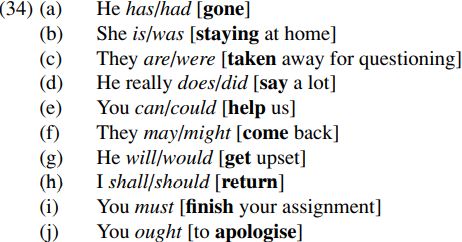


 Grammar
Grammar
 Tenses
Tenses
 Present
Present
 Past
Past
 Future
Future
 Parts Of Speech
Parts Of Speech
 Nouns
Nouns
 Verbs
Verbs
 Adverbs
Adverbs
 Adjectives
Adjectives
 Pronouns
Pronouns
 Pre Position
Pre Position
 Preposition by function
Preposition by function 
 Preposition by construction
Preposition by construction
 Conjunctions
Conjunctions
 Interjections
Interjections
 Grammar Rules
Grammar Rules
 Linguistics
Linguistics
 Semantics
Semantics
 Pragmatics
Pragmatics
 Reading Comprehension
Reading Comprehension|
Read More
Date: 2023-09-25
Date: 2023-06-19
Date: 2023-08-18
|
Having looked at the nominal functional category pronoun, we now turn to look at the verbal functional category auxiliary. Traditional grammarians use this term to denote a special class of items which once functioned simply as verbs, but in the course of the evolution of the English language have become sufficiently distinct from main verbs that they are now regarded as belonging to a different category of auxiliary (conventionally abbreviated to AUX).
Auxiliaries differ from main verbs in a number of ways. Whereas a typical main verb like want may take a range of different types of complement (e.g. an infinitival to-complement as in I want [(you) to go home], or a noun expression as in I want [lots of money]), by contrast auxiliaries typically allow only a verb expression as their complement, and have the semantic function of marking grammatical properties associated with the relevant verb, such as tense, aspect, voice, or mood. The items italicized in (34) below (in the use illustrated there) are traditionally categorized as auxiliaries taking a [bracketed] complement containing a bold-printed non-finite verb:

In the uses illustrated here, have/be in (34a,b) are (perfect/progressive) aspect auxiliaries, be in (34c) is a (passive) voice auxiliary, do in (34d) a (present/past) tense auxiliary, and can/could/may/might/will/would/shall/should/must/ought in (34e–j) modal auxiliaries. As will be apparent, ought differs from other modal auxiliaries like should which take an infinitive complement in requiring use of infinitival to.
There are clear syntactic differences between auxiliaries and verbs. For example (as we saw in §1.5), auxiliaries can undergo inversion (and thereby be moved into pre-subject position) in questions such as (35) below, where the inverted auxiliary is italicized and the subject is bold-printed:

By contrast, typical verbs do not themselves permit inversion, but rather require what is traditionally called do-support (i.e. they have inverted forms which require the use of the auxiliary do):

A second difference between auxiliaries and verbs is that auxiliaries can generally be directly negated by a following not (which can usually attach to the auxiliary in the guise of its contracted form n’t):

By contrast, verbs cannot themselves be directly negated by not/n’t, but require indirect negation through the use of do-support:

(Note that in structures such as John decided not to stay the negative particle not negates the infinitive complement to stay rather than the verb decided, as we see from the fact that the sentence can be paraphrased as ‘John decided that he would not stay’, not as ‘John did not decide that he would stay.’) And thirdly, auxiliaries can appear in sentence-final tags, as illustrated by the examples below (where the part of the sentence following the comma is traditionally referred to as a tag):

In contrast, verbs can’t themselves be used in tags, but rather require the use of do-tags:

So, on the basis of these (and other) syntactic properties, we can conclude that auxiliaries constitute a different category from verbs.
|
|
|
|
دراسة تحدد أفضل 4 وجبات صحية.. وأخطرها
|
|
|
|
|
|
|
جامعة الكفيل تحتفي بذكرى ولادة الإمام محمد الجواد (عليه السلام)
|
|
|